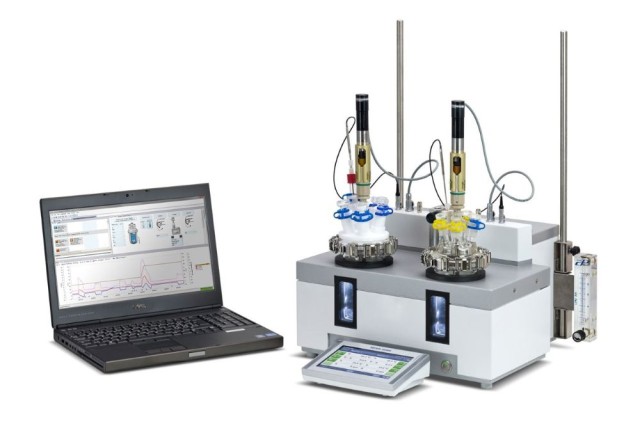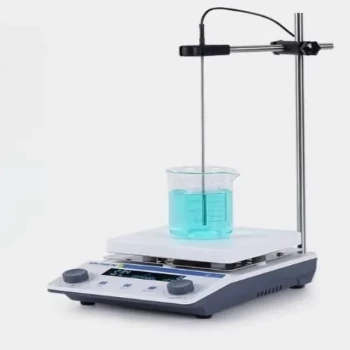고압 원자로
응용 분야
고압 반응기는 특히 극한 조건을 다루는 화학 연구 영역에서 없어서는 안 될 도구입니다. 이러한 특수 반응기는 고온 및 고압의 화학 반응을 견디고 촉진하도록 세심하게 설계되어 상당한 위험을 초래하는 물질을 취급하는 데 이상적입니다.
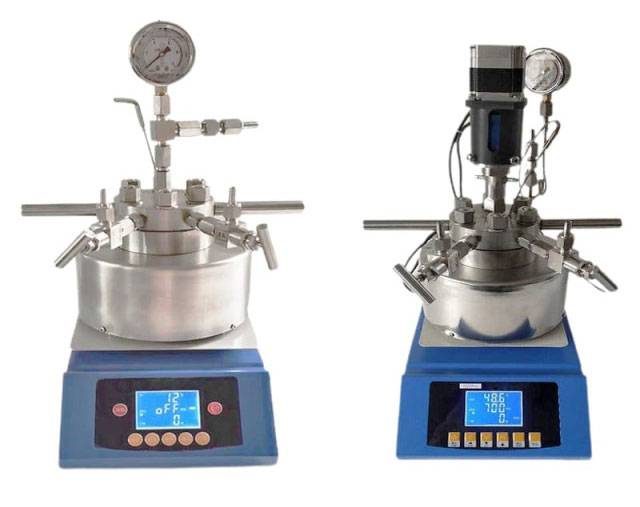
특히 고압 반응기는 인화성, 폭발성, 독성 매체를 다루는 실험에 필수적입니다. 견고한 구조로 안전성과 효율성을 보장하므로 연구자는 실험의 무결성을 손상시키지 않고 이러한 유해 물질을 조작할 수 있습니다. 이 기능은 반응 조건을 정밀하게 제어해야 하는 석유화학, 제약, 특수 화학 등의 산업에서 특히 유용합니다.
또한 고압 반응기의 다목적성은 안전성을 넘어서는 것입니다. 간단한 것부터 복잡한 것까지 다양한 화학 공정을 처리할 수 있어 광범위한 응용 분야가 가능합니다. 새로운 화합물을 합성하든, 반응 경로를 최적화하든, 반응 동역학을 연구하든, 고압 반응기는 원하는 결과를 달성하는 데 필요한 환경을 제공합니다.
요약하자면, 고압 반응기는 단순한 도구가 아니라 가장 까다로운 환경에서도 안전성과 기능성을 모두 제공하는 화학 연구 및 산업 공정의 발전에 필수적인 요소입니다.
유리 반응기
기능
유리 반응기는 다양한 반응 물질을 처리하는 데 중요한 이중 유리 구조로 설계되었습니다. 이 독특한 설계 덕분에 정상 및 음압 조건 모두에서 교반하는 등 다용도로 사용할 수 있습니다. 이중층 유리는 반응 모니터링을 위한 투명성을 제공할 뿐만 아니라 일정한 온도 제어를 용이하게 하여 안정적인 환경을 보장합니다. 이는 반응 과정 내내 정밀한 온도 조절을 유지할 수 있는 가열 및 냉각 시스템의 통합을 통해 달성됩니다.

온도 제어 외에도 이중 유리 구조는 강화된 안전 기능을 제공합니다. 외부 유리층은 보호 장벽 역할을 하여 우발적으로 위험 물질에 노출될 위험을 줄여줍니다. 이 설계는 누출 및 유출 가능성을 최소화하기 때문에 민감하거나 휘발성 화합물을 다룰 때 특히 유용합니다.
유리 반응기의 기능은 기본적인 교반 및 온도 제어 그 이상으로 확장됩니다. 자동 압력 조절 및 프로그래밍 가능한 제어 시스템과 같은 고급 기능도 갖추고 있습니다. 이러한 기능을 통해 연구자들은 복잡한 반응을 높은 정밀도와 재현성으로 수행할 수 있으므로 유리 반응기는 현대 실험실에서 없어서는 안 될 필수 도구입니다.
자기 리액터
밀봉 메커니즘
자기 리액터는 자기 커플러를 통합한 정교한 정적 밀봉 구조를 사용합니다. 이 설계는 누출 문제를 완화하여 완전히 밀폐된 작업 환경을 보장하는 데 핵심적인 역할을 합니다. 마그네틱 커플러는 비접촉식 전송 장치로 작동하여 직접적인 물리적 접촉 없이 토크와 모션을 전달할 수 있습니다. 이 기능은 미세한 누출로도 실험의 무결성과 안전이 손상될 수 있는 위험 물질을 취급할 때 특히 유용합니다.
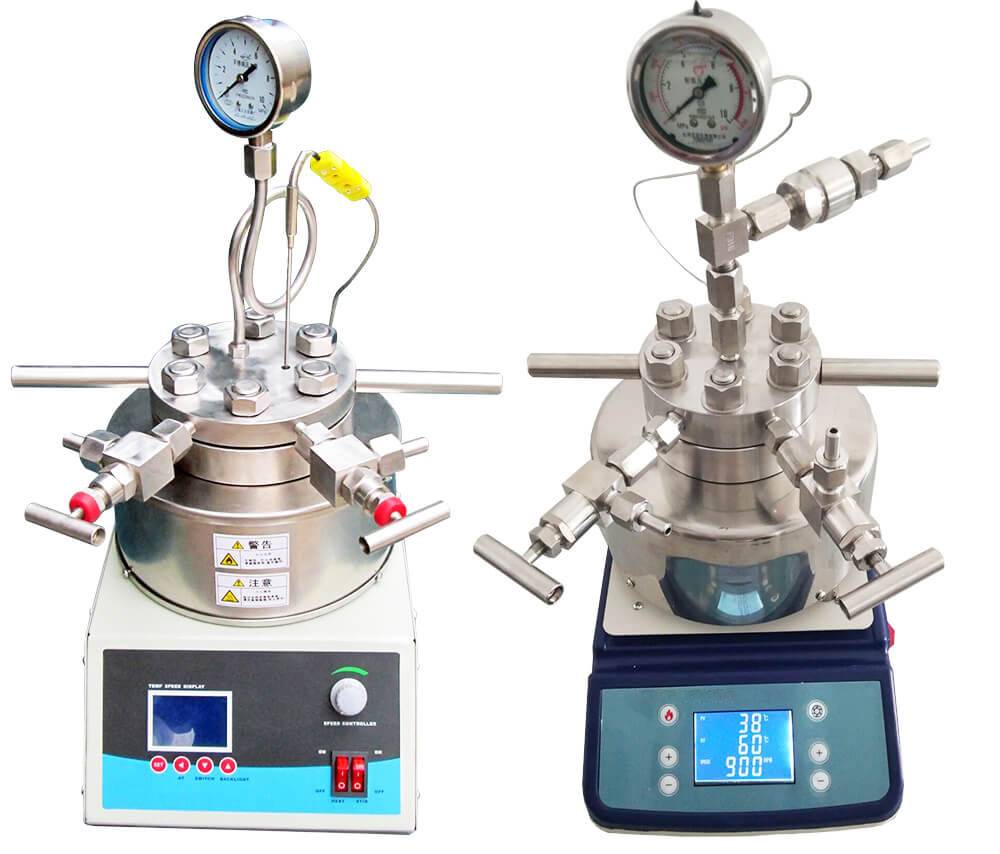
정적 밀봉 메커니즘은 자기장의 원리로 작동하며, 리액터의 내부 구성 요소와 상호 작용하여 기계적 밀봉 없이도 원활한 작동을 가능하게 합니다. 이 방식은 원자로의 내구성을 향상시킬 뿐만 아니라 유지보수 절차도 간소화합니다. 씰을 자주 교체할 필요가 없으므로 전체 운영 비용이 절감되므로 자기 리액터는 실험실에서 비용 효율적인 선택이 될 수 있습니다.
또한 완벽한 밀봉으로 반응 결과를 변화시킬 수 있는 외부 오염 물질이 없는 깨끗한 반응 환경을 유지할 수 있습니다. 이러한 수준의 환경 제어는 독성 또는 폭발성 매체를 사용하는 실험과 같이 정밀한 조건이 필요한 실험에 매우 중요합니다. 밀폐된 환경을 유지하는 자기 커플러의 효율성은 리액터가 고위험 연구 및 개발 활동에 적합하다는 점을 강조합니다.
마이크로파 합성기
촉매 반응
마이크로파 합성기는 유기 화학, 제약 및 생화학을 비롯한 다양한 영역에서 광범위한 반응을 촉매하는 데 중요한 역할을 합니다. 이러한 합성기는 마이크로파의 고유한 특성을 활용하여 반응 속도와 수율을 향상시키므로 현대 실험실에서 없어서는 안 될 도구입니다.
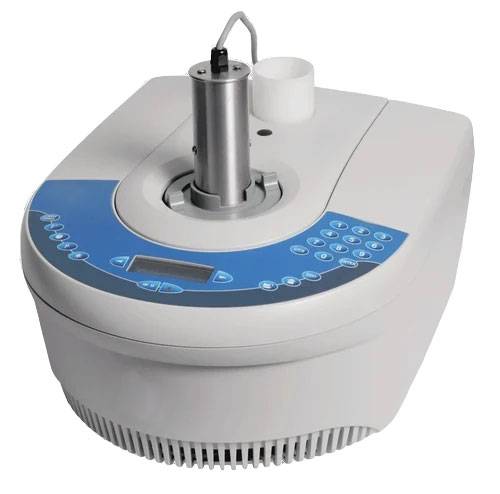
마이크로파 합성기의 주요 장점 중 하나는 복잡한 유기 반응을 촉진할 수 있다는 점입니다. 이러한 반응은 종종 온도와 압력에 대한 정밀한 제어가 필요한데, 마이크로파는 이러한 조건을 효율적으로 제공할 수 있습니다. 예를 들어, 의약품 합성에는 마이크로파가 제공하는 빠르고 균일한 가열의 이점을 누릴 수 있는 복잡한 분자 변형이 수반되는 경우가 많습니다.
생화학 분야에서는 생체 분자와 관련된 반응을 촉매하는 데 마이크로파 합성기가 사용됩니다. 이러한 반응은 열 및 기타 환경 요인에 대한 생물학적 물질의 민감성 때문에 특히 까다로울 수 있습니다. 마이크로파가 제공하는 제어된 가열과 빠른 반응 시간은 분해를 최소화하고 제품 순도를 극대화하는 데 도움이 됩니다.
마이크로파 합성기는 화학 반응 외에도 용매 추출과 같은 물리적 공정에서도 중요한 역할을 합니다. 이 기술은 복잡한 혼합물에서 귀중한 화합물을 추출하는 데 널리 사용되며, 마이크로파 에너지를 사용하여 프로세스를 크게 가속화하고 최적화할 수 있습니다.
요약하면 마이크로파 합성기는 다양한 과학 분야에 걸쳐 촉매 기능을 확장하여 실험실 연구 및 개발의 효율성과 효과를 모두 향상시키는 다용도 도구입니다.
반응 열량계
측정
반응 열량계는 화학 반응이나 물리적 공정 중에 방출되거나 흡수되는 열을 측정하도록 설계된 실험실에서 없어서는 안 될 도구입니다. 이 측정은 열화학 및 동역학 분야에 대한 통찰력을 얻는 데 중요하며, 다양한 공정에 관련된 에너지 변화와 반응 속도를 이해하는 데 필수적입니다.
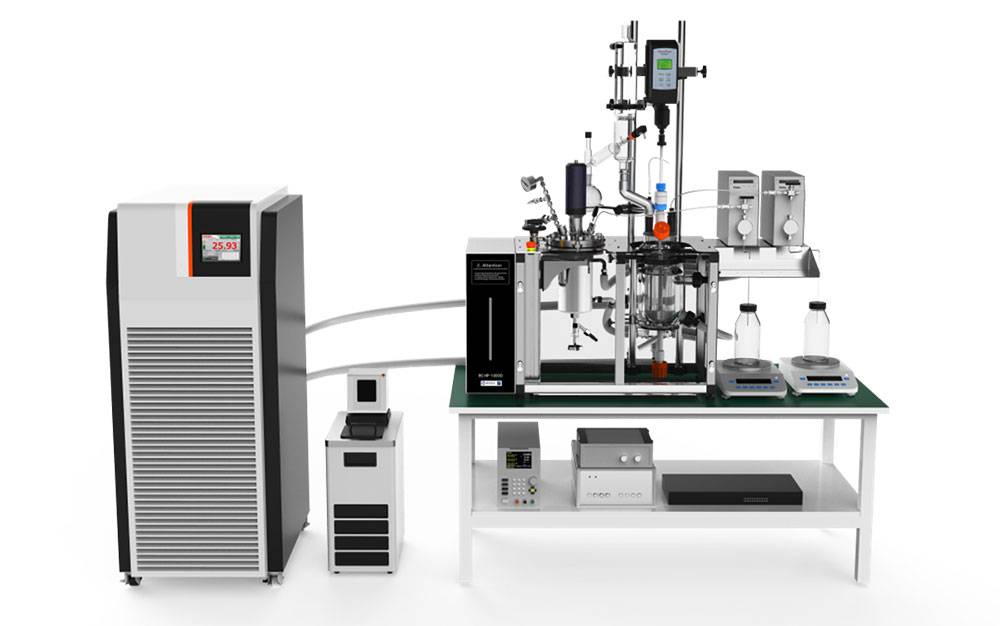
반응 열량계에서 수집한 데이터는 엔탈피 및 엔트로피 변화와 같은 반응의 열역학적 특성을 분석하는 데 사용할 수 있으며, 이는 반응 결과를 예측하고 반응 조건을 최적화하는 데 기본이 됩니다. 또한 활성화 에너지 및 반응 순서와 같은 이러한 측정에서 파생된 동역학 파라미터는 공정 제어 및 스케일업에 유용한 정보를 제공합니다.
| 측정 파라미터 | 열화학 인사이트 | 동역학 인사이트 |
|---|---|---|
| 열 방출/흡수 | 엔탈피 변화 | 반응 속도 |
| 온도 변화 | 엔트로피 변화 | 활성화 에너지 |
연구자들은 열 흐름을 모니터링함으로써 폭주 반응이나 과열로 이어질 수 있는 발열 반응과 같은 잠재적 위험을 식별하여 보다 안전한 실험실 운영을 보장할 수 있습니다. 열량 데이터를 다른 분석 기법과 통합하면 복잡한 반응 시스템에 대한 전반적인 이해가 향상되므로 반응 열량계는 현대 화학 연구 및 개발의 필수 구성 요소로 자리 잡았습니다.
촉매 평가 장치
평가 원리
촉매 평가 장치는 실제 반응 조건을 시뮬레이션하여 촉매의 효율성을 평가합니다. 이 평가는 주로 반응 생성물에서 파생된 지표를 기반으로 하며, 촉매의 효과를 측정하기 위해 세심하게 분석합니다. 이러한 평가 방법은 크게 정적 평가와 동적 평가의 두 가지 유형으로 분류됩니다.

정적 평가 는 실험 내내 반응 조건이 일정하게 유지되는 통제된 환경을 설정하는 것입니다. 이 방법은 안정된 조건에서 촉매의 초기 활성과 선택성을 연구하는 데 특히 유용합니다. 온도, 압력, 반응물 농도와 같은 주요 파라미터가 고정되어 있어 변동하는 변수의 간섭 없이 촉매의 성능을 자세히 분석할 수 있습니다.
동적 평가 반면 동적 평가는 반응 조건이 변화할 수 있는 보다 현실적인 산업 환경을 모방합니다. 이 접근 방식은 온도 변동이나 반응물 농도 변화와 같은 다양한 조건에서 촉매가 얼마나 잘 효율을 유지할 수 있는지 평가합니다. 동적 평가는 연속 공정에서 촉매의 장기적인 성능과 안정성을 예측하는 데 매우 중요하며, 정적 평가만으로는 얻을 수 없는 인사이트를 제공합니다.
| 평가 유형 | 주요 특징 | 응용 분야 |
|---|---|---|
| 정적 | 제어된 일정한 조건 | 초기 활동 및 선택성 연구 |
| 동적 | 가변 조건 | 연속 공정에서의 장기적인 성능 및 안정성 |
정적 및 동적 평가 방법은 촉매 효율을 종합적으로 평가하는 데 필수적이며, 선택한 촉매가 실제 응용 분야에서 직면하게 될 특정 반응 조건에 최적화되어 있는지 확인합니다.
합성 워크스테이션
자동화
첨단 컴퓨터 시스템으로 제어되는 완전 자동화된 합성 반응기는 화합물 및 약물 연구 분야에 혁명을 일으키고 있습니다. 이 정교한 기계는 공급, 가열, 교반, 증류 등 무수히 많은 공정을 정밀하고 효율적으로 처리합니다. 자동화는 실험의 재현성과 정확성을 향상시킬 뿐만 아니라 인적 오류의 위험을 줄여주며, 이는 섬세하고 위험 부담이 큰 연구 환경에서 특히 중요합니다.

이러한 자동화 시스템의 주요 장점 중 하나는 수동 개입 없이 복잡한 작업 순서를 관리할 수 있다는 점입니다. 이 기능은 아주 작은 편차가 최종 제품에 큰 변화를 가져올 수 있는 복잡한 화합물을 합성할 때 특히 유용합니다. 컴퓨터로 제어되는 시스템은 연구자가 미리 정의한 정확한 파라미터로 각 단계를 실행하여 여러 번의 실행에서 일관성을 유지합니다.
또한 자동화를 통해 연속 작업이 가능하므로 연구 프로세스의 속도를 크게 높일 수 있습니다. 연구원들은 실험을 야간이나 주말에 실행하도록 설정하여 실험실 시간을 최대한 활용할 수 있습니다. 이러한 연속 작동은 성능 저하 없이 장시간 사용에도 견딜 수 있도록 설계된 리액터의 견고한 설계 덕분에 가능합니다.
자동화된 합성 반응기는 운영상의 이점 외에도 실험실의 안전에도 기여합니다. 이러한 시스템은 가열 및 증류와 같은 위험한 프로세스를 처리함으로써 연구원이 잠재적으로 위험한 화학물질 및 조건에 노출되는 것을 최소화합니다. 이를 통해 연구팀의 건강과 안전을 보호할 뿐만 아니라 엄격한 실험실 안전 규정을 준수할 수 있습니다.
또한 컴퓨터 제어의 통합으로 실시간 모니터링과 데이터 로깅이 가능해져 연구자에게 반응 역학에 대한 귀중한 통찰력을 제공합니다. 이 데이터는 반응 조건을 최적화하고, 비효율적인 부분을 파악하고, 합성 공정을 개선하는 데 사용할 수 있습니다. 실시간으로 분석하고 조정할 수 있는 능력은 보다 효율적이고 효과적인 연구 성과로 이어질 수 있는 중요한 발전입니다.
요약하자면, 완전 자동화된 합성 반응기의 등장은 화합물 및 약물 연구 수행 방식의 중추적인 변화를 의미합니다. 이러한 시스템은 컴퓨터 제어 정밀도를 활용하여 재현성을 높이고, 연구 일정을 단축하며, 안전성을 개선하고, 공정 최적화를 위한 귀중한 데이터를 제공합니다. 이 기술이 계속 발전함에 따라 화학 합성 분야에 미치는 영향은 더욱 커져 새로운 발견과 혁신의 길을 열어줄 것입니다.
관련 제품
- 스테인리스 고압 오토클레이브 반응기 실험실 압력 반응기
- 실험실용 미니 SS 고압 오토클레이브 반응기
- 고급 과학 및 산업 응용 분야를 위한 맞춤형 고압 반응기
- 수열 합성용 고압 실험실 오토클브 반응기
- 실험실 소형 정온 가열 교반기
